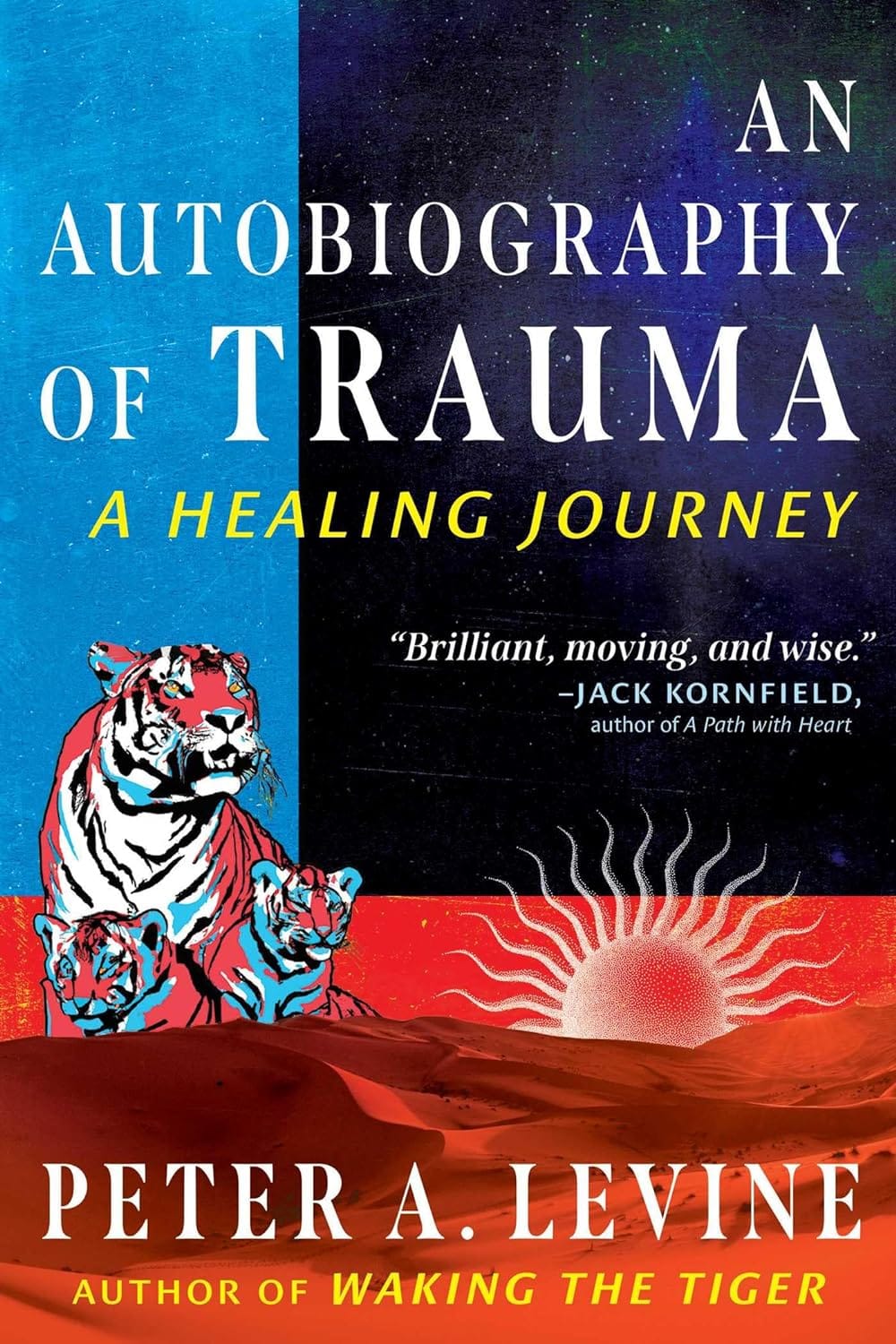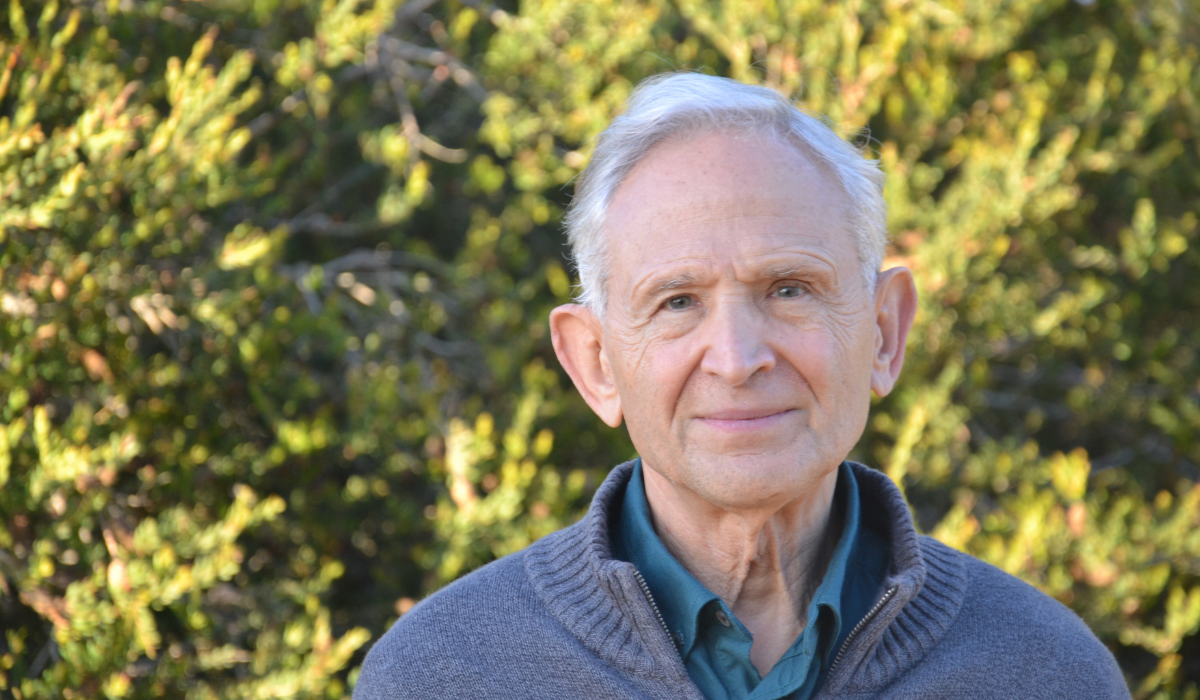Healing Trauma Starts In the Body. Psychotherapist Peter Levine Explains
"At my age, when I have fewer years ahead of me than I have behind me, I decided that it was time to do an excavation to follow my life story as a way of coming to peace with it."
That "excavation" Peter Levine, PhD, is talking about is his new book, An Autobiography of Trauma: A Healing Journey, in which he recounts the unsafety and trauma he experienced as a young boy and how he found healing from it.
Writing about how the intensities of life impact us is familiar to Levine. The 82-year-old psychotherapist and pioneering founder of Somatic Experiencing, a healing modality that focuses on the body to heal trauma and emotional wounds, has written numerous bestselling books about the critical role somatic—i.e., body-based—therapy plays in our holistic well-being, including our mental health. But writing about such a personal narrative was new. And, admittedly, daunting and vulnerable.
"This was not meant to be a book," he says while describing how the pages were only meant for his eyes, at first. "Then a dear friend said, 'Peter, you really should be writing this as a book.' And I said, 'No way. It's way too tender. And to expose myself would be almost unthinkable.'” Levine admits his friend continued to push him, but it was ultimately a dream that was the tipping point. "I wanted to make sure that this book could help people in their own healing, to tell their own stories," he says.
Levine's story is quite incredible, and it's moved humanity toward a deeper place of healing. He began developing Somatic Experiencing, known as "S.E.," in the late 1960s in Berkeley, California, while obtaining a Ph.D. Focusing on the body and its potential for healing was initially seen as "fringe," says Levine. But he persisted. Now S.E., which merges insights from physiology, psychology, ethology, biology, neuroscience, indigenous healing practices, and medical biophysics, is taught by more than 70 practitioners in 44 countries. The modality is a way to help people become more resilient, says Levine, and it aims to resolve trauma and stress that can accumulate in the body. "It's really something that's a perennial knowledge.”
In the weeks following the early April release of An Autobiography of Trauma, we spoke with Levine over Zoom to learn more about his journey in writing his new book, which he hopes will help people "soften into some of those wounds that they've been carrying." He also talks about how focusing on the body is a key to unlocking profound healing portals and how developing this method has been a lifetime journey. "I'm so glad," he says, "I was chosen to do this."
A CONVERSATION WITH PETER LEVINE PhD
Your development of Somatic Experiencing has a rich history. Tell us about the early days and how that spawned this teaching journey.
Over the past 50 years, I developed the approach, which started in the late 60s and early 70s. I first started to teach it to a group of Berkeley therapists. They would come to what we called "my tree house," and I would demonstrate with a person and then explain what I was doing and why. It went from 12 or 15 people to now 44 countries. When I started developing it, it was a weight on my shoulders. Do you know the story of Johnny Appleseed? He went from coast to coast, planting apple seeds wherever he could. I was sort of like the Johnny Appleseed of trauma healing. I would present it wherever I could and wherever there would be some interest. At the time, it was viewed as on the fringe—anything involving the body was. Can you imagine that? But I went forward, I continued. And I wrote several books, starting with Waking the Tiger. But this last book [An Autobiography of Trauma] is completely different. It's really the backstory of how I came through my own wounding.
In Greek mythology, one of the characters, an archetype, is Chiron. Chiron is the wounded healer. We all have our wounds. And if we're really to help others, we need to address those wounds. The word trauma comes from the Greek injury or wound. So, I look at it not just as a set of symptoms but as wounds that we all, to some degree, carry with us. And there are ways to transform these wounds. And again, that was a big part of writing the book to show the reader that it was possible to identify some of their wounds and transform them.
The word "trauma" seems to be getting more airtime these days. How do you view trauma?
I think trauma is probably the most ignored, belittled, and important thing that we shouldn't be ignoring. Because the consequences are serious—serious in terms of mental health, in terms of physical health, in terms of conflicts that keep repeating themselves in different parts of the world. At first, this was something that nobody talked about, and I think many people are talking about it now.
When I started developing my work, it was 12 to 13 years before there was a definition of trauma as PTSD, post-traumatic stress disorder. For me, this was something not just an array of symptoms but wounds and injuries that have happened to us and we carry with us into our present life, into our adult lives. So, I have an understanding of both the definition, but I think, more importantly, it is a way of looking at different woundings and finding ways to come to peace with those woundings. For me, that's the both sides of trauma.
In your new book, you give details about some horrible things you experienced growing up. Will you tell us more and how that shaped your path and your work in developing Somatic Experiencing?
I experienced a lot of severe trauma in an environment that was quite unsafe, where our whole family could have been executed. A person was threatening our life, someone who was the most violent in the mafia. So, [growing up], I was dealing with that life threat and not knowing what was happening because my parents never talked about it. We were never told, "Peter, we have this problem. It's not easy, but we will keep you safe." I never got that word about feeling safe.
[Years later] in working with one of my traumas, I started having these troubling symptoms: sensations and flashes of images. I asked one of my students to guide me and sit with me to see where these symptoms were coming from. In Somatic Experiencing, we don't go right to the core of the trauma, but we look for an embodied experience that contradicts that of terror, fear, and overwhelming helplessness. The first thing that came up for me was an event when I was about four or five on my birthday. My parents snuck into my bedroom at night and laid a model train set in an oval, so when I awoke, the train was going around in the room. To say I was excited would be a great understatement. I didn't have the words then, but at that moment, I knew that I was cared for and loved. So, even [the trama] what happened after that, I was able to balance it with that bodily experience of being cared for and being loved.
But again, [my family and I] lived with a threat for many years. At one time, I was violently attacked, but I never told my parents. In a way, I never even told it to myself. I kept it hidden away from me, and that's what we do when there's an extreme trauma: We compartmentalize it. It exists outside of our conscious awareness. It was only when I started having these symptoms and sensations and got aid from my student that I was able to excavate that, move through with it, and heal it. That's a lot of what the book is about: taking these things that happen, looking not right into the core of it, not smashing into it, but touching into it. And in touching into it, then coming back stronger, more resilient. Because SE is an approach that enhances resilience, rather than trying to erase trauma memories or change their negative thoughts. It's a very, very different approach. And at the time, it was revolutionary. Now, there are hundreds, probably thousands, of books about trauma. Bringing the body in is now becoming more and more mainstream.
You write that we all have the capacity to heal and we have "a fundamental primal drive toward wholeness and health." What do you say to the person who maybe is despondent or overwhelmed and doesn’t know how to listen to their body, let alone acknowledge their trauma?
You have to go gently. Because it's in the body, you can see the collapse and depression in the body or the turning down in shame. These are all things that the body does. Often, when you can work with the person when they become aware of that body state and what the opposite of that body state would be, they often find themselves freed from some of that gripping despair and despondency. Sometimes, it takes a while; often, it often doesn't happen all at once. But with persistence, courage, and enlisting that primal drive toward wholeness and healing, it can take people where they need to go and where they want to go. Without this drive healing wouldn't be possible. It is essential to the healing process because we're not erasing the person's trauma. We're not helping them to change their negative thoughts. It's really about creating these new experiences in the body, which contradict those of overwhelming helplessness. And again, that became the core feature of Somatic Experiencing.
What is one exercise that pulls from the wisdom of SE that we can use today?
I suggest many exercises in the book. One is I have people gently hold their upper arms, maybe gently squeezing, so they can feel how that is helping them contain what they feel so they're not as overwhelmed. Also, many of us didn't get adequate hugging. So, how does it feel when you are holding yourself? If you're just willing to explore that for a few minutes, what do you begin to notice? Sometimes, all of a sudden, tears of relief stream down people's faces.
It helps to have somebody there with you, at least initially, to take your hand. A Motown song goes, "One can stand alone in the dark. Two can make a light shine through." Trauma isn't so much what happened to us, or it's certainly not just what happened to us. Rather, it's what we hold inside in the absence of that present, empathetic other. How important that is, and how important that was for me in my life.

Peter A Levine, Ph.D., is the developer of Somatic Experiencing®, a naturalistic and neurobiological approach to healing trauma. He holds a doctorate in Biophysics and a doctorate in Psychology. He is the Founder and President of the Ergos Institute for Somatic Education, and the Founder and Advisor for Somatic Experiencing International. Levine is the author of several best-selling books on trauma. Learn more at somaticexperiencing.com.
Please note that we may receive affiliate commissions from the sales of linked products.



